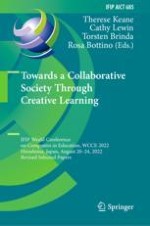2023 | Book
Towards a Collaborative Society Through Creative Learning
IFIP World Conference on Computers in Education, WCCE 2022, Hiroshima, Japan, August 20–24, 2022, Revised Selected Papers
Editors: Therese Keane, Cathy Lewin, Torsten Brinda, Rosa Bottino
Publisher: Springer Nature Switzerland
Book Series : IFIP Advances in Information and Communication Technology
